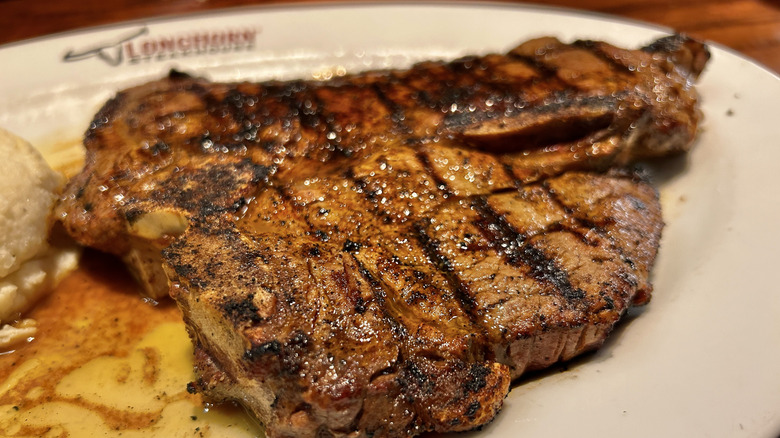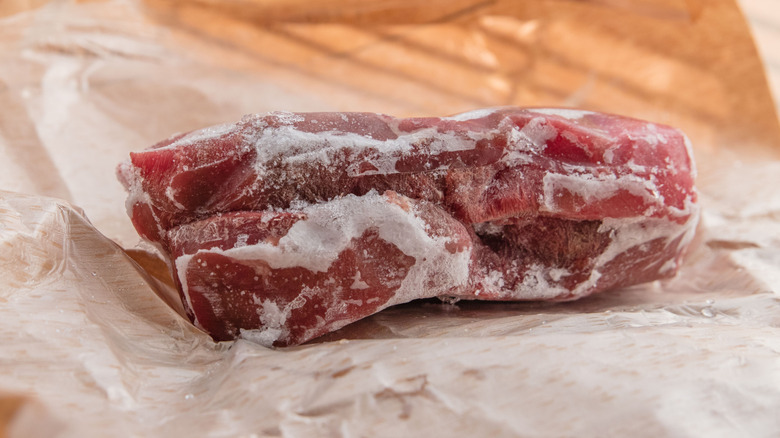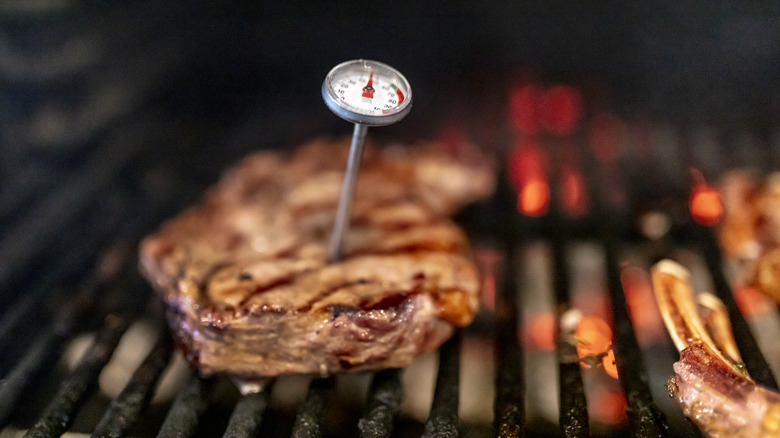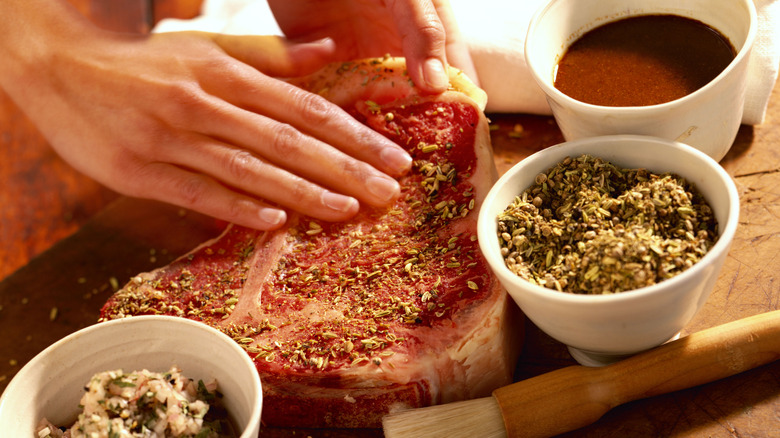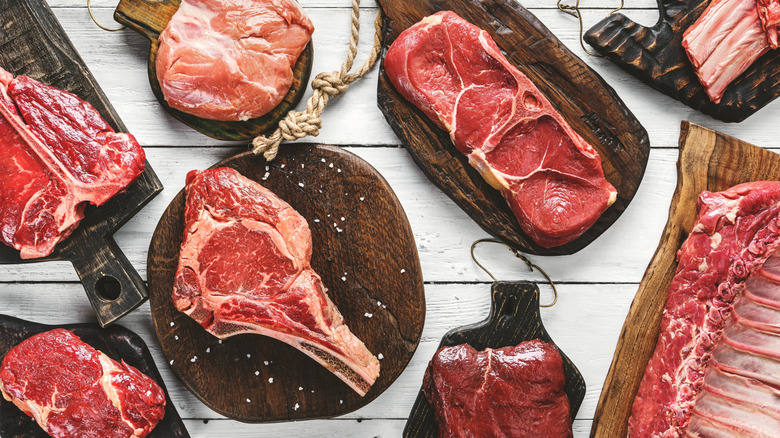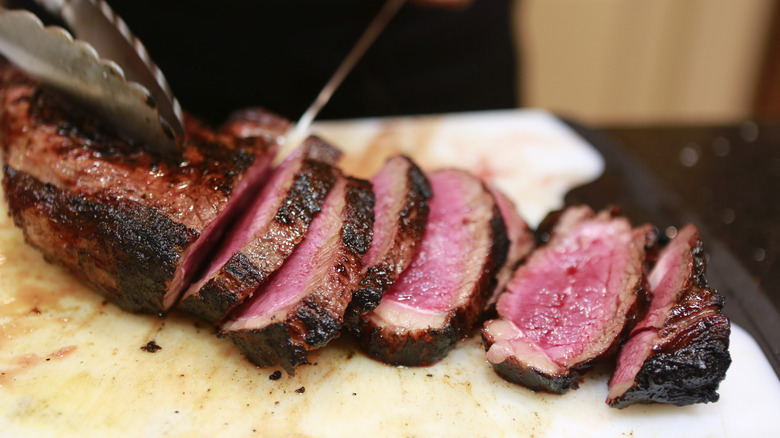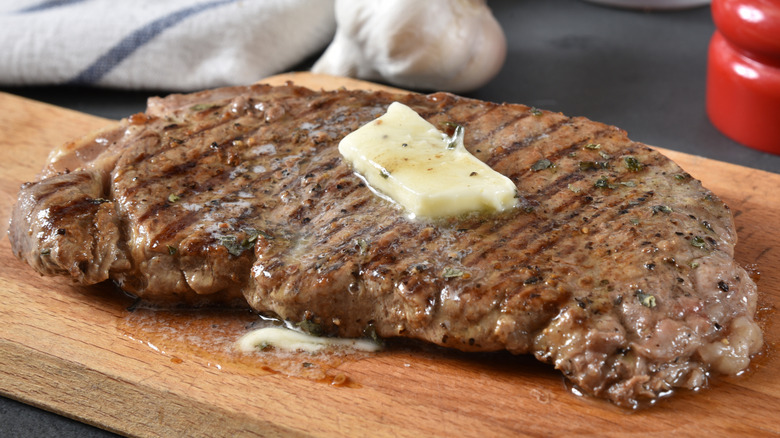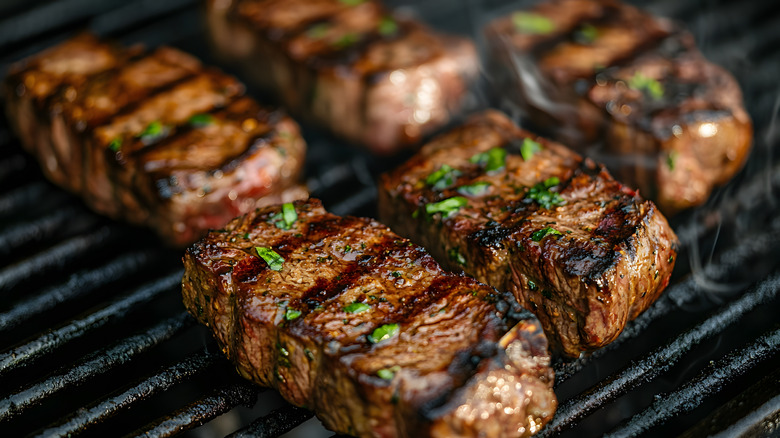This Is What Makes LongHorn Signature Steaks So Good
There is just something so satisfying about enjoying a great steak dinner at LongHorn Steakhouse. While many a hobbyist grillmaster can recreate a great piece of red meat at home, for most of us, restaurant steaks still stand out. Fans of the chain will agree that LongHorn signature steaks are some of the best mid-range options — but what is it about them that makes them so good?
As a longtime fan of and frequent diner at the restaurant myself, I am happy to spill the secrets. Here, I've combined my personal insights with advice from former LongHorn waitstaff and information scoured from the company's website — as well as its parent company, Darden. The key takeaways seem to be: A transparency throughout the preparation process and a willingness to listen to what the customer wants, which includes changing the meat to fit these needs. However, to really understand what makes LongHorn signature steaks so good, you'll just have to taste them for yourself.
Each steak is fresh, never frozen
The steaks at LongHorn Steakhouse are never once frozen — instead, they arrive at each restaurant fresh and are cooked shortly after. This way, the flavor isn't compromised. Freezing meat typically helps it last longer if you don't plan to cook it right away. Yet for restaurants, the amount of meat each location goes through means the steaks are likely cooked and served on a more compressed timeline. This eliminates the need for freezing.
Plus, a study published in the 2012 Nebraska Beef Cattle Report found freezing meat before thawing it out to cook it can change its fat content.The amount of fat present in meat can heavily impact its flavor. Tasting freezer burn is also a risk when eating something that has been frozen poorly or sat around waiting for too long. At LongHorn, enjoying a steak that has only ever been chilled before cooking eliminates these issues and will make things taste better overall.
All steaks are cooked to order — even in wild and wooly ways
While it may be true that some restaurants don't want you to order a well-done steak, this isn't the case at LongHorn Steakhouse, as I've eaten there multiple times with someone who prefers well done meat with no issues at all. This flexibility is one of the biggest reasons the steaks here are so tasty: They are entirely cooked to order. From bleu (the rarest of the rare) to well done and everything in between, just tell your waiter what you like and they will make it happen. You can even order things that are a touch less traditional, like a Pittsburgh rare steak. A Pittsburgh rare steak is grilled until it's crispy on the outside while staying very rare or almost raw on the inside, giving it a nice contrast in texture (for some ... I am not personally a fan!).
If you aren't sure about the difference between medium rare and medium well, simply ask a member of the waitstaff. It can be helpful to have it explained in person, especially when considering different cuts and what works best for each, like prime rib versus flank.
You can adjust them to fit your needs
While chicken-fried steak might not officially be on the menu at most LongHorn Steakhouse locations, if you have a hankering for a little bit of crunch with your red meat, you're in luck — the restaurant offers something similar. In an exclusive for Tasting Table, an employee of the chain with almost ten years experience explained that adding a crunchy parm topping to any of the steaks is not only possible, but delicious, too. "I have seen just about everything parm crusted," Emilee Unterkoefler told the outlet. "Some of the most memorable include parm-crusted salmon, steak tips, chicken tenders, and mashed potatoes, and they actually all sound delicious."
She went on to explain that the topping is a great mixture of a classic ranch dressing with herbs and parmesan cheese for flavor, along with panko breadcrumbs to give it a classic crunch. "Consider upgrading your burger, sirloin, or filet with a parm crust topping as a unique way to enhance your dinner next time you go in," she explained. Per conversations I've also had with the waitstaff on my many visits, sometimes there is a small upcharge to add the crusting, but the exact price depends on the location you are visiting.
The seasonings are fully-customizable
Each of the LongHorn signature steaks comes with a classic rub already worked into the meat, so some might find the blend of spices a bit too salty for their tastes. I often fall into this camp and request light seasoning — which doesn't make the steak taste bland. Instead, I find that it just allows me to discover the more natural flavor of the meat. However, one of the best things about this range is that you can easily change the seasonings.
If you are thinking about swapping things around, however, there are definitely a few guidelines to follow to avoid encountering a flavor disaster. "Flat-top and char seasonings are almost identical; the only difference is that flat-top seasoning contains dill seed, but char seasoning does not," Unterkoefler told Tasting Table. "When dill seeds cook over an open flame, it burns and gives off an unpleasant taste, so I do not recommend swapping the two." So if you don't want a burned, bitter tasting steak, avoid making this substitution.
An option that is bound to make things better every single time, however, is asking for the seven-pepper seasoning on a steak. Unterkoefler revealed that although the mix is typically only served with the seven-pepper sirloin salad, it will taste just as good on almost any other steak, too. "It will seriously spruce up a boring sirloin and tastes perfect on a New York strip," she said.
There are so many different cuts to choose from
No matter what your taste in steak is, there is something for you here! I have tried the most expensive LongHorn Steakhouse steak vs the cheapest and can tell you whatever your budget, and whatever your flavor preferences (from lots of fat to nice and trim), the menu has it all. For a little extra help, here is a quick rundown of a few of the steaks the chain offers:
First, the filet steak is a tender, lean cut from the beef tenderloin. People tend to like it because it has a soft texture and milder flavor. The Ribeye, which as you likely guessed gets its name from the rib area, is rich and juicy due to its high fat content. Sirloin, from the back, offers a balance of leanness and flavor, making it a budget-friendly option (and my personal favorite). A New York Strip is firm with moderate fat that enhances its beefy taste. Finally, the T-Bone steak features both tenderloin and New York strip separated by a T-shaped bone, combining soft and firm textures — so it's a good option if you just can't choose between cuts.
The recipes also aren't a secret
LongHorn is serious about good steak — so much so that the recipes aren't a secret. In fact, the restaurant chain has plenty of options for recreating meals for its locations available publicly on its website. Not only that, but in the past, budding home chefs for first time cooks could even call a dedicated LongHorn Steakhouse hotline to ask questions. The "Grill Us" hotline allowed the public to access personalized information about how best to cook their steaks, which cut they might like, and which seasonings would really make the meat pop.
The total transparency here is one of the reasons the LongHorn signature steaks are so good. The company has such a solid product that it doesn't need to keep anything about it concealed. In fact, it actually seems like the higher ups are actively encouraging diners to recreate the in-house experience at home. My guess, as a fan of the chain who has indeed tried to make the steakhouse quality steaks at home, too, is that although I appreciate the transparency and guidance, I can never do it quite right. This leads me to return to my nearest location over and over for meals, still making a profit for the company.
Those with food allergies can dine safely
Dining out can be a real drag for anyone with a food allergy. Reactions to an introduced allergen can range from a mildly upset stomach all the way to anaphylaxis and even death. It's important to take food allergies seriously — yet anyone who has ever dined out with one will know that this is not always the case. Luckily, when enjoying a signature steak at LongHorn, diners don't have to worry about getting ambushed with their allergy. The company publishes exactly what is in each dish in an extensive allergen guide.
For example, if you react to soy, a common allergy, you will need to avoid the chopped steak and the Renegade Sirloin, as it is present in both — as is dairy, too. Each of the listed sides also has complete allergen information available. While it's always possible to speak to the waitstaff, and sometimes the manager and chef, too, about allergies when dining out, it's always nice to take some of the guesswork out of the process and get the correct information beforehand. Such is the case when ordering a signature steak from LongHorn.
Each steak is cooked on the grill that does it best
Not every steak responds the same way to similar cooking methods. The chefs at LongHorn Steakhouse know this, so they adjust their cooking methods to bring out the best in each cut. For example, at each restaurant, meat can be cooked on either a flat top grill or a char grill. The main difference between the two is that the flat top simply heats the meat, while the char grill allows the flames access to the meat for char marks — which add flavor.
At LongHorn, "steaks that cook on the char grill include the outlaw ribeye, the porterhouse, and the T-bone, which are all of higher quality than some of the other steaks on the menu," Unterkoefler told TastingTable. Other less premium quality means like a filet or regular ribeye are cooked on the flat top. However, it's possible to ask your waiter to cook these on the char grill, too. "I recommend requesting it is cooked on the char grill," she continued. "The seasoning, plus the flame-kissed lines, deliver a superior flavor all day long. The char flavor enhances your steak in a way a flat-top grill simply can't."
Static Media owns and operates Daily Meal and Tasting Table.
